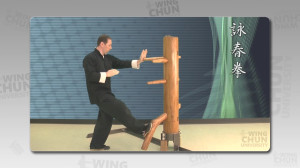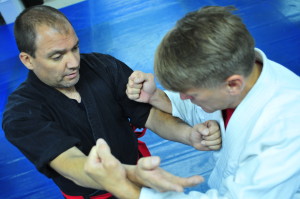The original purpose of this article was to document the differences in a handful of Wing Chun lineage’s Wooden Dummy form. However, what I quickly learned was that this is not an easy task in a written format… And I feel it would be unfair to say that ALL Wing Chun people from XZY lineage do such and such.
The reason I bring this up is that I am quickly discovering that many high level Wing Chun people are often influenced by more than one person. For example, I believe that most WC practitioners can agree that Ip Man learned from, and was influenced by, Chan Wah Shun and Leung Bik in some shape or form.
Rather than a comparison of three different lineages, we thought it would better represent the art if we shared three different perspectives of the mok yan jong. We asked these three well known teachers, “What can you learn from the dummy?”
Below is some of the information I collected:
Sifu Wayne Belonoha from the Moy Yat/Sunny Tang Lineage:
 One of the first things that Sifu Belonoha made clear in our conversation is that his teacher, Sunny Tang was taught by Grandmaster Moy Yat, a student of Ip Man. Although Sunny Tang also trained with Grandmaster Ip Man directly, it is best to make that distinction as it’s important to him to represent his lineage clearly while also being clear that his lineage strives to pass along the skills unchanged.
One of the first things that Sifu Belonoha made clear in our conversation is that his teacher, Sunny Tang was taught by Grandmaster Moy Yat, a student of Ip Man. Although Sunny Tang also trained with Grandmaster Ip Man directly, it is best to make that distinction as it’s important to him to represent his lineage clearly while also being clear that his lineage strives to pass along the skills unchanged.
From his perceptive I got the impression that the dummy is something that best saved for the advanced student. He described the dummy as a tool that, “helped refine my techniques. It acted like very fine grit sandpaper, smoothing out the smallest rough edge.” In other words, while you can get some benefit from reading “Advanced Astrophysics”, the real value comes when the book is read by those with more knowledge and experience with the material already.
He also spoke about the different phases of learning the dummy. In Sifu Belonoha’s opinion, the first thing one must do is to learn proper technique and positioning. He went on to say “by doing proper technique one will learn when the elbows leak energy, when the techniques are off center, how to remain facing the shape, proper distance and when the timing is not correct. Without proper positioning and distance, proper techniques will be difficult, as will the transition to the next move in the form.”
From the interactions I had with Sifu Belonoha and from watching his videos, I see that he heavily stresses the minor details. I AM NOT stating that other lineages or other people in Wing Chun do not have similar views, but he clearly puts a heavy emphasis on mastering the little details that make a big differences.
Michael Quijano from the Wong Shun Leung/Victor Koo lineage
Sifu Quijano studied with a number of high level Wing Chun practitioners, including Moy Yat, Moy Bah Hugn, Jessie Glover, and Victor Koo.
He points out that the dummy form he learned from Victor Koo is not drastically different from any other lineage he has studied, but rather the difference was in him. When he learned the dummy from Moy Yat and Moy Bah Hugn he was younger and not as experienced.
 He pointed out that, “although I knew the dummy form, concepts and applications, I had not refined it. Over the years, while training with Sifu Koo, I believe that what he shared with me was the concept of bringing the dummy more alive. He ingrained in me more of the concepts and made them more realistic for me.” Sifu Quijano made it very clear he received an excellent Wing Chun education from Moy Yat and Moy Bah Hugn, any fault for not fully understanding its applications was HIS mistake. Sifu Koo improved and/or corrected the issues he had with the wooden dummy, enhancing his marital arts knowledge.
He pointed out that, “although I knew the dummy form, concepts and applications, I had not refined it. Over the years, while training with Sifu Koo, I believe that what he shared with me was the concept of bringing the dummy more alive. He ingrained in me more of the concepts and made them more realistic for me.” Sifu Quijano made it very clear he received an excellent Wing Chun education from Moy Yat and Moy Bah Hugn, any fault for not fully understanding its applications was HIS mistake. Sifu Koo improved and/or corrected the issues he had with the wooden dummy, enhancing his marital arts knowledge.
Similar to Sifu Wayne Belonoha, he pointed out that the dummy is not a tool to “bang” on. Rather it teaches you about the relationship of you, your opponent, how to stand and move, angles, chase the center (not the arms), and the most important of all recovery. He stated that the dummy can teach you more than what is listed above, but the dummy is there to correct your errors.
Speaking with Sifu Quijano is always a great experience. He has a “no-nonsense attitude” towards fighting and I always learn a lot. The biggest thing I took away from this conversation is that your Wing Chun is always in a state of constant refinement. The system is not something you learn once and can walk away from.
Philip Romero from the Hawkins Chueng Lineage
From a past conversation I had with Sifu Romero it was very clear his teacher, Hawkins Cheung, a direct student of Ip Man, is a master of body structure and how to utilize it in combat.
According to Sifu Romero, he taught the dummy as a “protractor for teaching theory for angles. Hawkins was able to develop timing at a very close range, or as he would say ‘inch power pressure.’” He went on to tell me about how Hawkins would often talk about “anglelongation timing theory” and applied it to dummy training.
I (Scott, the writer of this article) would be lying if I said a completely understood this advance theory, but to break it down into laymen terms, it is finding the “sweet spot” in your opponents structure to uproot or attack them.
 In a follow up conversation Sifu Romero stated “yes, it is to find the sweet spot or the true center line and then stay on it as they create more pressure to stack the body up right and take it off center. At that point you can create any situation because you have control of the center with any angle. You have to control the opponent in order to make the attack, this is the only way you are going to suspend the human through timing and center or top dead center (TDC.) Another way too look at is that you’re creating vectors to and through the center for very controlled angles, followed by ATTACK………!”
In a follow up conversation Sifu Romero stated “yes, it is to find the sweet spot or the true center line and then stay on it as they create more pressure to stack the body up right and take it off center. At that point you can create any situation because you have control of the center with any angle. You have to control the opponent in order to make the attack, this is the only way you are going to suspend the human through timing and center or top dead center (TDC.) Another way too look at is that you’re creating vectors to and through the center for very controlled angles, followed by ATTACK………!”
Sifu Romero went onto explain, during the opening sequence of the form, Hawkins is able to raise the dummy up and then suspend it on the slats that hold up the dummy, release it, and then he would repeat the same sequence again.
Hawkins also teaches how to apply this in application as well. Sifu Romero told us how even in Chi Sau Hawkins is capable of uprooting his opponent. Romero referred to this as “stacking a human” to throw or lock them.
Sifu Philip Romero has a great understanding of Hawkins Chueng’s theories and is able to apply them to combat well. It is always fascinating to hear what it is like to train with a direct student of Ip Man.
Conclusion:
If I had to sum up my experience of “what does the dummy teach you” it would have to be the following:
- Correct past mistakes (further refinement of skill).
- Your ability to understand and interpret the system.
- It does not matter which lineage you study, it matters who you study with.
The biggest afterthought I have is that it does not matter what lineage you study. The teacher you learn from and the time and dedication put into the dummy is more important then anything else. I have always been told that Wing Chun is a very individualized system.
In some shape or form, your teacher, or teacher’s teacher, had to learn from a number of different people to master the system. This might mean that they had learned from more than one teacher, they fought or sparred with different styles, or both.
In one way or another, their experiences influenced their interpretation of Wing Chun and how wooden dummy form was passed onto them. What will you do to ensure your interpretation of the system is correct and follows the laws of Wing Chun?
After publishing this article we received a lot of questions about purchasing dummies. We suggest you check out WingChunGeeks.Com guide to buying a Wing Chun Wooden Dummy. They explain the most common FAQ’s and have a very detailed article regarding this topic. For those who want to see which dummies we currently have available, check out this page on EverythingWingChun.com

Thanks for the post. It is always refreshing to see a familiar subject from a new angle! I for one would like to hear some more about Hawkins Cheung’s theory.
Very nice, I agree with what has been said. The wooden dummy can serve many functions these are but a few.